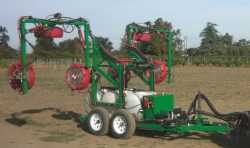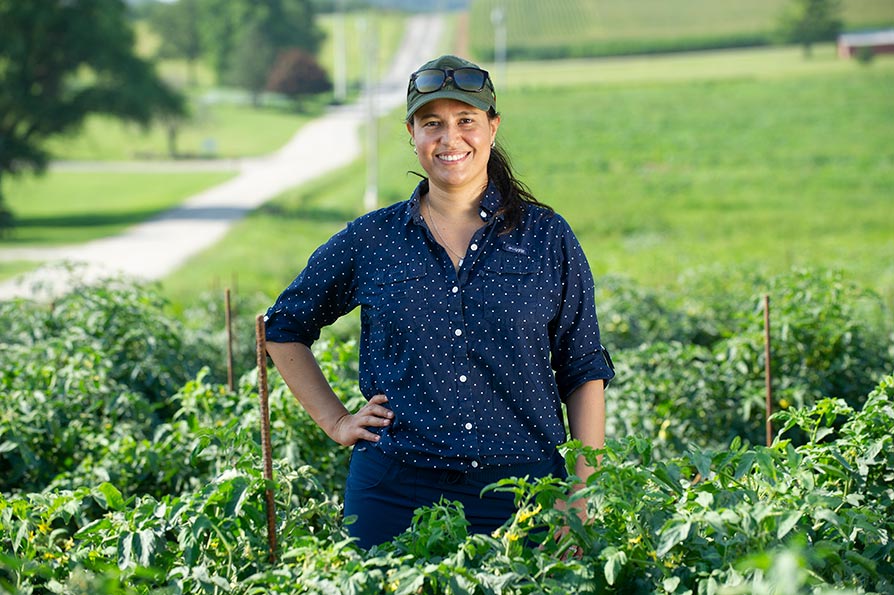Ways To Save On Grape Spraying

Net grower income is the difference between crop price and farming costs. From year to year, growers who sell to a wholesale market generally have more control over production costs than crop price. This is especially true in perennial crops, where the variety, planting density, and other yield determining factors are established with the orchard or vineyard. Cost saving technologies and practices that maintain or improve crop quality may offer growers the best chance to improve their bottom line in the short term. Unfortunately, it can be difficult to determine which technology or practices offer the best return on investment.
Grape growers are in luck. A recent study from Ryan Billing and Ken Giles at the University of California-Davis Ag and Biological Engineering Department provides information that allows the ranking of cost saving practices in spray applications in vineyards by the amount of projected savings. This may help growers decide where the best return on investment can be found.
Comparing Sprayers
As a graduate student in Dr. Giles’ lab, Billing designed and built a two-row sprayer that delivered spray through nozzles placed on remote fans operating from around the sides and top of adjacent vine rows. The sprayer was built with three poly tanks arranged in parallel and controlled from the tractor seat, allowing the operator to select and apply different spray mixtures across the vineyard, based on monitoring information obtained before spraying. For example, spot sprays for a particular insect and/or disease pest could be applied at the same time a cover spray for powdery mildew control goes out over the whole block. The tractor PTO powers a hydraulic pump used to run the system (six fans, spray pump, etc.).
Billing field-tested his sprayer against a conventional (axial fan) airblast sprayer (Model TR1500, OMA, Bologna, Italy) in a 10-foot row, VSP trellised vineyard. He documented slightly improved coverage — no statistical difference — using a dye tracer (not pesticide residues or pest control) on the exterior and interior of the canopy between his sprayer at 50 gallons per acre (gpa) and the conventional at 100 gpa. Both sprayers were operated at 2 miles per hour (mph) ground speed; however, the design and configuration of the Billing sprayer allowed for equal coverage at lower volumes. Billing also compared spray coverage at two ground speeds (2.0 vs. 3.8 mph) using his sprayer at 50 gpa spray volume. Interior canopy spray deposition was significantly less at the faster ground speed.
More Is Better
Having established that his sprayer worked as well or better than a conventional sprayer at half the spray volume at 2 mph under the sprayer settings and field conditions of this study, Billing parked the sprayer and ran a cost analysis for different hypothetical configurations of his sprayer to see what changes in sprayer setup and/or design might mean to spray application costs. While not all of the comparisons were tested in the field, this work shows where potential savings could be achieved by changes in sprayer setup and/or design.
The single largest cost reduction practice was changing rows sprayed per tractor pass. Moving from one to two rows sprayed per tractor pass produced the largest savings per acre, followed by going from two to three rows sprayed per pass. Additional savings were found with increasing number of rows sprayed per sprayer pass beyond three, but the gains were much less relative to those found for moving up to three rows per pass. Spraying two rows per pass compared with spraying down every row reduced time to spray a 40-acre vineyard by more than half (11.7 hours vs. 23.4 hours). Adding rows sprayed per pass doesn’t necessarily mean the ground speed or spray volume (gpa) changes, but the sprayer spends less time in the vineyard compared to a sprayer working a fewer number of rows per pass with the same settings and equipment.
Increasing tractor speed — on a spread sheet, not tested in the field — from 1 to 6 mph decreased costs, but most of the savings was obtained in moving from low to medium speeds. Increasing tractor speeds from 2 to 3 mph (50% change) reduced application costs per acre by 24%, while increasing tractor speeds from 3 to 4 mph only further reduced costs 7% from the 2 mph application. Increasing tractor speeds down 10-foot rows requires increased operator attention to avoid damage to vines and equipment and a smooth vineyard floor to reduce bouncing and swaying of fans. The potential increase in cost savings of high sprayer speeds needs to also consider the reduction in coverage to the interior parts of the canopy at high speed.
Billing determined that reducing spray volume per acre (gpa) and increasing sprayer tank size are separate practices that stretch the time between tank fills and thus reduce costs. However, these changes resulted in smaller cost savings than did passes per row or tractor speed practices that decrease sprayer time in the vineyard. Examples of the relative cost savings from each practice or technology compared — passes per row, sprayer ground speed, spray volume per acre, and tank size — are shown in “Money-Saving Adjustments.”
Billing estimated that a grower with a 26-acre vineyard could save $10,000 over two years spraying with a two-row sprayer using 50 gpa spray volume and traveling at 2 mph compared to a standard airblast sprayer traveling down every row at the same speed and spraying 100 gpa, ignoring interest and service life. Considering interest and assuming the same net cost to operate each machine, the annual savings (per year) over a ten-year period amounts to $6,580.
Big Savings Potential
What is the take-home message from this work? There is potential for significant cost savings using multi-row sprayers in vineyards — even relatively small vineyards — without reducing spray coverage. The ground speeds and spray volumes tested were not intended as implied recommendations. This project was conducted to compare different sprayers and sprayer setups in a single vineyard under a certain set of conditions.
The authors recognize that spray volume needed for efficient and effective pest control in a particular planting changes through the season. For example, research by Dr. Andrew Landers at Cornell University has determined that the spray volume retained by a grape vine can double or triple from early to mid-season as the canopy grows. That is, 25 gpa might be all that is needed to achieve excellent foliar coverage early in the season, depending on the vineyard age, planting density, and training system, but the same vineyard might require 50 to 75 gpa in mid-season to achieve the same coverage. Using one spray volume for all foliar sprays through the entire season could result in wasteful spray runoff early in the season and risky, insufficient coverage at full canopy. Spray volumes needed to control insects hidden deep in rough bark or grape clusters may be significantly more than that required for adequate leaf coverage.
In conclusion, significant cost savings are possible with new spray application technologies and practices. A number of sprayer manufacturers offer units that are marketed as multi-row sprayers. Not all use the Australian-made SARDI fans that Billing built into his sprayer. Any new practice or technology should be carefully evaluated under the conditions and location(s) where it will be used.
One final note: Every other row spraying with a conventional airblast sprayer is a bad idea — bad for spray coverage, bad for pest management, and bad for resistance management. It may work early in the season when there is little to no shoot growth and canopy to slow the movement of sprayer air and the pesticide it carries to the far side of the vine, but certainly not once leaf expansion has occurred.










